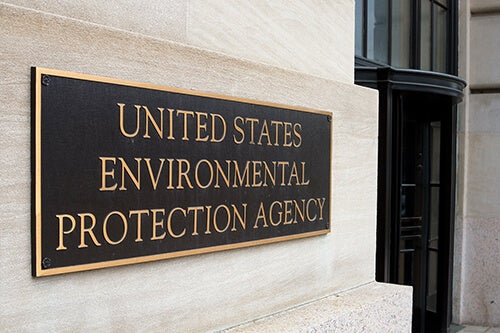

On January 1, 2023, manufacturers of products with intentionally added perfluoroalkyl and polyfluoroalkyl substances (PFAS) must report them to the Maine Department of Environmental Protection (DEP). Manufacturers can also no longer sell carpets, rugs, or fabric treatments containing intentionally added PFAS after that date.
These two requirements are part of Maine’s law, An Act To Stop Perfluoroalkyl and Polyfluoroalkyl Substances Pollution. Manufacturers that fail to comply will face civil or criminal penalties. Read on to learn what this law means for you and what steps you can take to ensure you’re compliant.
PFAS: A Primer
Perfluoroalkyl and polyfluoroalkyl substances are a family of durable, synthetic fluorocarbons that are persistent, bioaccumulative, and toxic. There may be as many as 12,000 substances in the PFAS family.
These substances have long been used for water- and oil-proofing, extinguishing fires, and providing non-stick surfaces. But these properties also mean the materials have difficulty breaking down over time due to their tight chemical bonds, which is why they’re sometimes called “forever chemicals.”
Studies show potential adverse human health effects from exposure to some members of the PFAS family, including:
- Increased risk of thyroid disease
- Increased blood cholesterol levels
- Decreased fertility in women
- Low infant birth weight
Due to their toxic nature and prevalence, more and more jurisdictions have enacted regulations, or are considering enacting regulations, to limit their usage.
Maine’s PFAS Regulations
In July 2021, Maine’s legislature passed An Act To Stop Perfluoroalkyl and Polyfluoroalkyl Substances Pollution. The new law includes a broad definition of PFAS that goes beyond the list of 1,364 substances that the U.S. Environmental Protection Agency (EPA) proposed under the Toxic Substances Control Act (TSCA) Section 8(a)(7) Reporting Rule. Rather, the latest revision of Maine’s final rule points to the EPA’s CompTox list of PFAS, which contains over 12,000 entries.
Last month, the Maine DEP issued its second concept draft rule, which is currently open for public comments until November 10, 2022. More information, including a Frequently Asked Questions section and a recording of the public meeting held on October 27, 2022, is available on the state’s PFAS in Products website.
Who’s in Scope?
All manufacturers that place products on the market in the state of Maine are in scope of this law, unless they’ve been specifically excluded. In the most recent draft of the law, the manufacturer is the brand owner, although it could be an importer or the first domestic distributor of the product. If you sell, offer for sale, or distribute products in Maine, you’re in scope of the law. “Offering for sale” means that you make a product available for sale, including through online platforms that deliver to Maine.
Some manufacturers have been granted extensions by the DEP, although those extensions have been granted on a case-by-case basis, not on an industry group-level.
Important Provisions in the Law
There are two important provisions in this law, both of which come into effect on January 1, 2023:
- Reporting products with intentionally added PFAS to the DEP
- Prohibiting the sale of carpet, rugs, and fabric treatments containing intentionally added PFAS
Reporting
While the law created a reporting requirement, the DEP is still developing a database to collect these reports. During an October 2022 public meeting, state officials explained that even if there is no database ready by the beginning of 2023, reporting remains a requirement. The DEP will release an FAQ on how to submit these reports in absence of a database, although they have expressed a preference for data to be e-mailed in common electronic formats such as spreadsheets or tables. There is a $250 USD fee for the first three notifications and an additional $50 USD for each additional notification.
During the webinar, DEP officials made it clear the agency does not have the authority to grant wholesale extensions or exemptions regarding the reporting requirements as they are bound by the requirements of the statute. They expect manufacturers to provide preliminary notifications beginning in January 2023, unless an individual extension has been approved. After the final rule is adopted, manufacturers have three months to submit their final notifications.
Notably, PFAS in medical devices must be reported under Maine law. This requirement stands in contrast to the EPA’s proposed TSCA Section 8(a)(7) reporting requirements, which exempt medical devices as they are outside EPA authority and are instead regulated by the Food and Drug Administration (FDA). Since that exemption is only at the federal level, medical device manufacturers should be aware of state-level requirements around PFAS that will impact them even if they are exempt from federal rules.
PFAS in Products Prohibition
The second crucial provision of the Maine law is a prohibition on the sale of carpets, rugs, and fabric treatments containing intentionally added PFAS starting January 1, 2023. By 2030, Maine will prohibit the sale of any product containing intentionally added PFAS. However, the state will exempt products with PFAS if the DEP deems that the use of those chemicals is unavoidable.
The department plans to examine incoming reporting data to understand how, where, and why PFAS are being used and will rely on this information to determine “currently unavoidable” uses that may be allowed even after the 2030 prohibitions take effect.
How Manufacturers Can Prepare
With the reporting deadline and PFAS prohibitions on certain items fast approaching, manufacturers must prepare to comply with these new rules.
To meet requirements, manufacturers must know where they’re using PFAS chemicals, so understanding the composition of products is a crucial first step to compliance.
If they don’t know where in the supply chain PFAS chemicals are used, manufacturers can start by identifying where PFAS properties are found (e.g., waterproof or non-stick characteristics). Many regulations already restrict several PFAS substances, like perfluorooctanoic acid (PFOA) and perfluorooctane sulfonate (PFOS), so manufacturers with robust supply chain data collection programs may already have information on these commonly regulated substances.
In Assent’s September 2022 PFAS Regulatory Update webinar, we covered some common PFAS properties and identified some materials that frequently use the substances. We also discussed a roadmap for identifying it in the supply chain.
Work With Assent to Meet PFAS Requirements Quickly
Assent helps manufacturers uncover hidden risks in their supply chain, going deeper than suppliers to their products, even substances within parts, to identify risks like the presence of PFAS.
Assent already offers solutions that cover commonly restricted PFAS, including our REACH SVHC and Proposition 65 solutions, and we’re always improving our solution to cover you as new PFAS regulations emerge. To learn more about meeting your PFAS requirements with Assent. Contact us.









